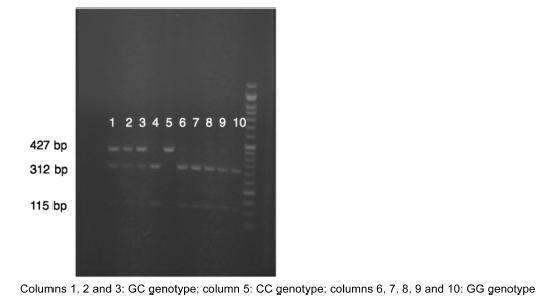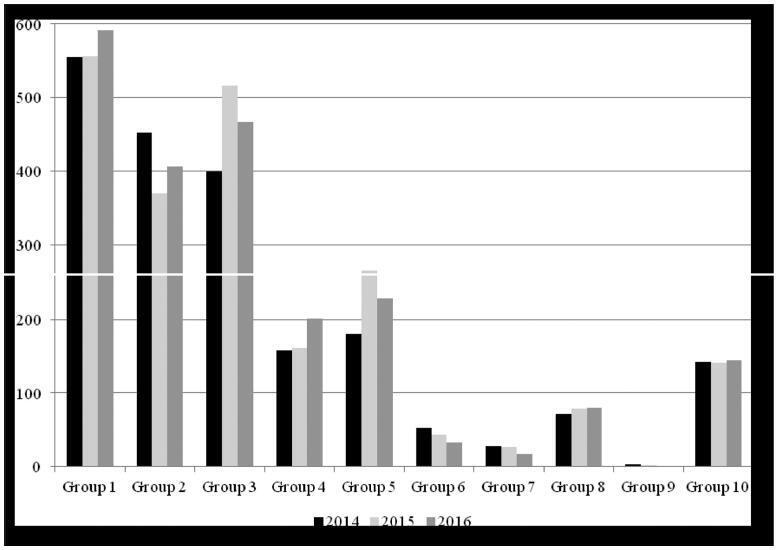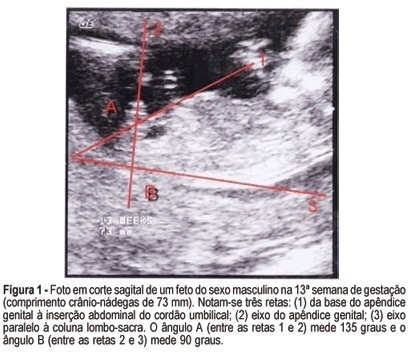Summary
Revista Brasileira de Ginecologia e Obstetrícia. 2019;41(1):31-36
To evaluate the rs42524 polymorphism of the procollagen type I alpha (α) 2 (COL1A2) gene as a factor related to the development of pelvic organ prolapse (POP) in Brazilian women.
The present study involved 112 women with POP stages III and IV (case group) and 180 women with POP stages zero and I (control group). Other clinical data were obtained by interviewing the patients about their medical history, and blood was also collected from the volunteers for the extraction of genomic DNA. The promoter region of the COL1A2 gene containing the rs42524 polymorphism was amplified, and the discrimination between the G and C variants was performed by digestion of the polymerase chain reaction (PCR) products with the MspA1I enzyme followed by agarose gel electrophoresis analysis.
A total of 292 women were analyzed. In the case group, 71 had the G/G genotype, 33 had the G/C genotype, and 7 had the C/C genotype. In turn, the ratio in the control group was 117 G/G, 51 G/C, and 11 C/C. There were no significant differences between the groups.
Our data did not show an association between the COL1A2 polymorphism and the occurrence of POP.

Summary
Revista Brasileira de Ginecologia e Obstetrícia. 2020;42(6):310-315
The Robson 10 group classification system (RTGCS) is a reproducible, clinically relevant and prospective classification system proposed by the World Health Organization (WHO) as a global standard for assessing, monitoring and comparing cesarean section (CS) rates. The purpose of the present study is to analyze CS rates according to the RTGCS over a 3-year period and to identify the main contributors to this rate.
We reviewed data regarding deliveries performed from 2014 up to 2016 in a tertiary hospital in Portugal, and classified all women according to the RTGCS. We analyzed the CS rate in each group.
We included data from 6,369 deliveries. Groups 1 (n = 1,703), 2 (n = 1,229) and 3 (n = 1,382) represented 67.7% of the obstetric population. The global CS rate was 25% (n = 1,594). Groups 1, 2, 5 and 10 were responsible for 74.2% of global CS deliveries.
As expected, Groups 1, 2, 5 and 10 were the greatest contributors to the overall CS rate. An attempt to increase the number of vaginal deliveries in these groups, especially in Groups 2 and 5, might contribute to the reduction of the CS rate.

Summary
Revista Brasileira de Ginecologia e Obstetrícia. 2014;36(7):310-314
DOI 10.1590/SO100-720320140005008
The objective of this study was to investigate the relationship between overactive bladder syndrome and anxiety in older women.
Of the 198 older women who were invited, 29 were excluded and 166 were then divided into two groups according to the Advanced Questionnaire of Overactive Bladder (OAB-V8): one group with overactive bladder symptoms (OAB-V8≥8) and the other without the symptoms of an overactive bladder (OAB-V8<8). The purpose was to conduct a frequency analysis and to investigate the relation of the social demographic data and anxiety in the two groups. The Beck Anxiety Inventory (BAI) was used to evaluate the level of anxiety. The Kolmogorov-Smirnov test was used to determine the distribution of the data. The differences between the two groups for the continuous variables were analyzed by the Mann-Whitney U test, the differences for the categorical variables were analyzed by the Chi-Square test and the association between the continuous variables was analyzed by the Spearman Correlation test. The tests were two-tailed with a confidence level of 5%.
Overall, the frequency of an overactive bladder was present in 117 (70.5%) of the participants. The body mass index (BMI) of the group with overactive bladder symptoms was significantly higher than the BMI of those without these symptoms (p=0.001). A higher prevalence of mild, moderate and severe anxiety was observed among older women with overactive bladder symptoms. In addition, the overactive bladder symptoms group presented a positive low correlation with anxiety symptoms (r=0.345) and with BMI (r=0.281). There was a small correlation between BMI and anxiety symptoms (r=0.164).
Overactive bladder syndrome was prevalent among older women and the existence of these symptoms was linked to the presence of mild, moderate and/or severe anxiety symptoms.
Summary
Revista Brasileira de Ginecologia e Obstetrícia. 2005;27(6):310-315
DOI 10.1590/S0100-72032005000600004
PURPOSE: to evaluate the accuracy of fetal gender prediction at 11 to 13 weeks and 6 days by measuring the anterior and posterior genital tubercle angles. MESTHODS: the anterior and posterior genital tubercle angles were measured in a midsagittal plane in 455 fetuses from 11 to 13 weeks and 6 days. The probability of a correct fetal sex prediction (confirmed after birth) was categorized in accordance with the angle measurements, gestational age and crump-rump length. The optimal accuracy cutoffs were derived from a ROC-plot. The interobserver variability was evaluated by a Bland-Altman plot. RESULTS: the correct fetal sex prediction rate increased with gestational age and crump-rump length. Using a 42-degree anterior angle as a cutoff, a correct fetal sex prediction occurred in 72% of the fetuses from 11 to 11 weeks and 6 days, 86% from 12 to 12 weeks and 6 days and 88% from 13 to 13 weeks and 6 days. Using a 24-degree posterior angle as a cutoff, a correct fetal gender prediction occurred in 70, 87 and 87%, respectively. The interobserver variability evaluation revealed a mean difference between paired measurements of 15.7 and 9 degrees for the posterior and anterior angles, respectively. CONCLUSION: the measurement of the genital tubercle angles showed a high accuracy in correctly predicting the fetal sex from the 12th week of gestation on. However, accuracy was still not high enough for clinical use in pregnancies at risk of serious X-linked diseases.

Summary
Revista Brasileira de Ginecologia e Obstetrícia. 2011;33(10):310-314
DOI 10.1590/S0100-72032011001000007
PURPOSE: to evaluate the effect of hormone replacement therapy (HT) on the weight on perimenopausal women as well as the effect of different treatment regimens on this parameter. METHODS: a retrospective study of 139 women with menopause for less than 2 years, who were monitored with periodical visits in our department. We compared two groups: women who started HT (n=89) with women who had no hormonal treatment (n=50) and in the two groups, we evaluated the changes in body weight over a 1-year period. In the first group, we assessed the same parameter as a function of different treatment regimens: estrogen alone versus estrogen combined with progestin and standard dose versus low dose. The SPSS® program was used for statistical analysis, with the level of significance set at p<0.05. RESULTS: the groups were similar with respect to demographic and baseline characteristics; weight gain was higher in the untreated group (434 vs 76 g), but the difference observed was not significant (p = 0.406); among HT users, those taking estrogen alone had an increased weight gain compared to women taking estrogen with progestin (775 vs 24 g), although no statistically significant difference was observed and the same applied when comparing the dose initially prescribed (92 vs 49 g). CONCLUSIONS: despite the common belief about weight gain associated with HT, the results of the present study seem to contradict this point, with no additional weight gain beyond that normally associated with this period in a woman´s life.
Summary